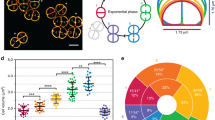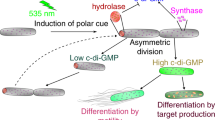Abstract
ENDOSPORE formation in bacteria can be regarded as a primitive form of cellular differentiation as the mature spore has many features, both structural and biochemical, which distinguish it clearly from the growing cell. The extent to which bacterial sporulation can be used as a simple model for development in higher organisms depends on the similarity or otherwise of the control processes which influence cellular differentiation in both cases. It would thus seem important to draw as close an analogy as possible between prokaryotic and eukaryotic differentiating systems. With this in mind, the effect of 5-bromo-2′-deoxy-uridine (BUdR) on growth and sporulation in Bacillus subtilis has been investigated. When incorporated into the DNA of eukaryotic cells, BUdR (an analogue of thymidine, TdR) selectively affects processes associated with differentiated and embryogenesis, without significantly altering cell growth or gross RNA and protein synthesis1–3. The effects seem best explained by an alteration in transcription2,4,5, possibly caused by tighter binding of chromosomal proteins6–8. This may also be true for prokaryotes, because purified lac represser and catabolite gene activator protein from E. coli bind more tightly to BUdR-substituted DNA8. Sporulation in B. subtilis is controlled to a considerable extent by sequential activation of genes, many of which remain repressed during vegetative growth (for review see ref. 9). We report here that BUdR, at a concentration which leaves growth unaffected, markedly reduces the capacity of B. subtilis to sporulate. This effect is comparable with the known interference of this analogue with cellular differentiation in eukaryotes.
This is a preview of subscription content, access via your institution
Access options
Subscribe to this journal
Receive 51 print issues and online access
$199.00 per year
only $3.90 per issue
Buy this article
- Purchase on Springer Link
- Instant access to full article PDF
Prices may be subject to local taxes which are calculated during checkout
Similar content being viewed by others
References
Holtzer, H. et al. Curr. Top. dev. Biol. 7, 229–256 (1972).
Rutter, W. J., Pictet, R. L. & Morris, P. W. A. Rev. Biochem. 42, 601–646 (1973)
Guespin-Michel, J. F. et al. Expl Cell Res. 98, 184–190 (1976).
Hill, B. T., Tsuboi, A. & Baserga, R. Proc. natn. Acad. Sci. U.S.A. 71, 455–459 (1974).
Jones, T. C. & Dove, W. F. J. molec. Biol. 64, 409–416 (1972).
Lapeyre, J. N. & Bekhor, I. J. molec. Biol. 89, 137–162 (1974).
Lin, S.-Y., Lin, D. & Riggs, A. D. Nucleic Acids Res. 3, 2183–2191 (1976).
Lin, S.-Y. & Riggs, A. D. Biochim. biophys. Acta 432, 185–191 (1976).
Piggot, P. J. & Coote, J. G. Bact. Rev. 40, 908–962 (1976).
Sterlini, J. M. & Mandelstam, J. Biochem. J. 113, 29–37 (1969).
Bishop, R. J. & Sueoka, N. J. Bact. 112, 870–876 (1972).
Wake, R. G. & Baldwin, R. C. J. molec. Biol. 5, 201–216 (1962).
Schildkraut, C. L., Marmur, J. & Doty, P. J. molec. Biol. 4, 430–443 (1962).
Laird, C. D. & Bodmer, W. F. J. Bact. 94, 1277–1278 (1967).
Dancer, B. & Mandelstam, J. J. Bact. 121, 406–410 (1975).
Coote, J. G. J. Bact. 120, 1102–1108 (1974).
Mandelstam, J., Sterlini, J. M. & Kay, D. Biochem. J. 125, 635–641 (1971).
Dawes, I. W., Kay, D. & Mandelstam, J. Nature 230, 635–641 (1971).
Yamamoto, T. & Balassa, G. Molec. gen. Genet. 106, 1–13 (1969).
Bohin, J. P., Rigomier, D. & Schaeffer, P. J. Bact. 127, 934–940 (1976).
Glenn, A. R. & Coote, J. G. Biochem. J. 152, 85–89 (1975).
Author information
Authors and Affiliations
Rights and permissions
About this article
Cite this article
COOTE, J. Interference by bromodeoxyuridine with differentiation in a prokaryote. Nature 267, 635–637 (1977). https://doi.org/10.1038/267635a0
Received:
Accepted:
Issue Date:
DOI: https://doi.org/10.1038/267635a0
Comments
By submitting a comment you agree to abide by our Terms and Community Guidelines. If you find something abusive or that does not comply with our terms or guidelines please flag it as inappropriate.



